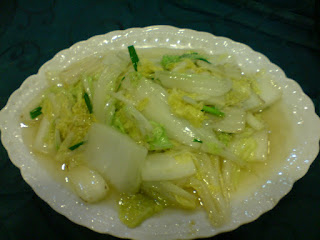Food is also on the cheap in China too. Of course you can find plenty of restaurants that will cost an arm and a leg to eat at; but for eating on a daily basis there is a different option. Previously I would shop at the supermarket and buy enough groceries to feed me for a whole week. I was saving money -- or so I thought.
Since moving to Wenzhou I found that my working hours meant I had to eat out more and more. At first the cost was worrying, but then I realised that by regularly eating at "sensible" restaurants I was actually not spending any more money than I did at the supermarket. The food in these places is simple home-style Chinese cooking which is actually very healthy and completely different from our Western-produced Chinese food.
Tonight we went to the local Chongqing restaurant that serves some spicy dishes, almost identical to Sichuan style food. Inside, the restaurant has been recently refurbished and would look quite modern and chic if it was 1978. It's a comfortable environment with adequate air conditioning (a must if spicy food is on the menu), plenty of tables and waiters that haven't learnt to smile.
Three dishes are usually enough for two people to share. Tonight we ate:
- Mapo Tofu
 One of my favourite Chinese dishes is Mapo Tofu. It's filled with a variety of spices, some of which can actually numb the inside of your mouth temporarily. The heat of this dish changes from day to day, sometimes it's very pleasant to eat and other times completely unbearable. That's part of the surprise.
One of my favourite Chinese dishes is Mapo Tofu. It's filled with a variety of spices, some of which can actually numb the inside of your mouth temporarily. The heat of this dish changes from day to day, sometimes it's very pleasant to eat and other times completely unbearable. That's part of the surprise.- Chinese Cabbage

I'm not exactly sure of the English word for this vegetable. It literally translates as "White Cabbage" but I'm certain such a name doesn't actually exist. The Chinese know how to do vegetables and this is one of the best examples of how effective simple cooking can be. There are no hidden calories or trans fats in this.
- Aubergine
 This dish consists of slices of Aubergine (they're usually purple and thinner in China) with spring onion, garlic and soy sauce. Usually, the chefs like to add tiny pieces of pork into this dish (and the Tofu too) which doesn't really benefit the dish at all. For me, it can be annoying because I am a vegetarian. Occasionally when we ask for no meat ("bu yao fan rou"), they put it in anyway.
This dish consists of slices of Aubergine (they're usually purple and thinner in China) with spring onion, garlic and soy sauce. Usually, the chefs like to add tiny pieces of pork into this dish (and the Tofu too) which doesn't really benefit the dish at all. For me, it can be annoying because I am a vegetarian. Occasionally when we ask for no meat ("bu yao fan rou"), they put it in anyway.- One bowl of rice
 Well, of course a Chinese meal wouldn't be complete without a bowl of boiled rice.
Well, of course a Chinese meal wouldn't be complete without a bowl of boiled rice.So how much does all of this cost I hear you ask? Considering there is strictly no tipping in this country, the total comes to a breath-taking £2.00.
And that's why I love eating in China.

3 comments:
It's called "Mapo Doufu" in chinese!! :)
The "White Cabbage" you were referring to is Napa.
Thank you Leni Grace, I have actually never heard of its English name before. At last I finally know what to say to my students when they ask me what da bai tai is in English!
Post a Comment